英文论文基本结构
- 格式:doc
- 大小:85.50 KB
- 文档页数:14
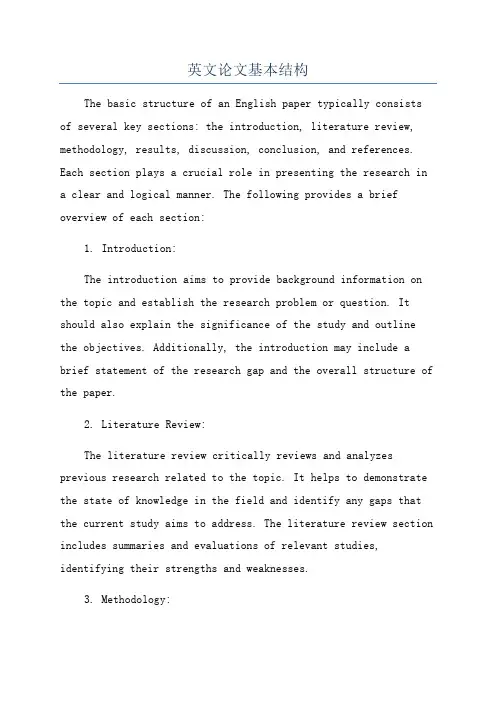
英文论文基本结构The basic structure of an English paper typically consists of several key sections: the introduction, literature review, methodology, results, discussion, conclusion, and references. Each section plays a crucial role in presenting the research in a clear and logical manner. The following provides a brief overview of each section:1. Introduction:The introduction aims to provide background information on the topic and establish the research problem or question. It should also explain the significance of the study and outline the objectives. Additionally, the introduction may include a brief statement of the research gap and the overall structure of the paper.2. Literature Review:The literature review critically reviews and analyzes previous research related to the topic. It helps to demonstrate the state of knowledge in the field and identify any gaps that the current study aims to address. The literature review section includes summaries and evaluations of relevant studies, identifying their strengths and weaknesses.3. Methodology:The methodology section describes the research design, participants, materials, and procedures used in the study. It explains how data was collected or generated and provides details about the data analysis techniques employed. This section enables other researchers to replicate the study and assess the reliability of the findings.4. Results:The results section presents the findings derived from the data analysis. It typically includes statistical analyses, figures, and tables that summarize and interpret the data. The results should be presented objectively without interpretation or discussion.5. Discussion:6. Conclusion:The conclusion summarizes the main findings of the study, reiterating their significance and potential implications. It should address the research question and briefly recapitulate the key points discussed in the paper. Additionally, the conclusion may suggest areas for further research or practical applications of the findings.7. References:The references section lists all the sources cited in the paper using a specific citation style such as APA or MLA. It isimportant to accurately and consistently document the sources to avoid plagiarism and provide readers with the means to locate the referenced material.。
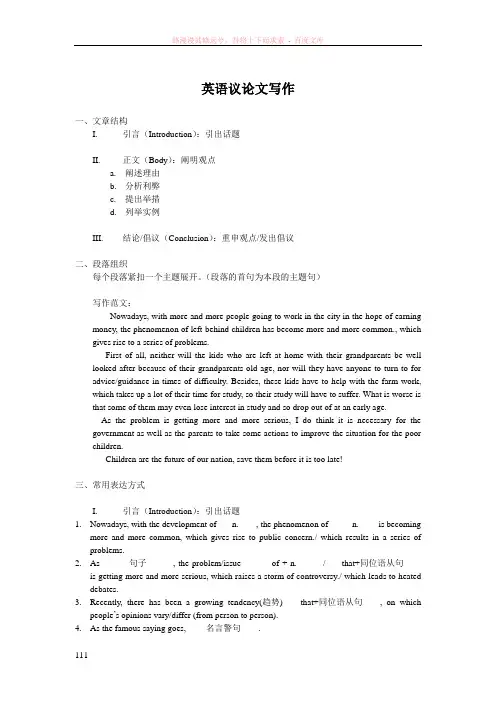
英语议论文写作一、文章结构I.引言(Introduction):引出话题II.正文(Body):阐明观点a.阐述理由b.分析利弊c.提出举措d.列举实例III.结论/倡议(Conclusion):重申观点/发出倡议二、段落组织每个段落紧扣一个主题展开。
(段落的首句为本段的主题句)写作范文:Nowadays, with more and more people going to work in the city in the hope of earning money, the phenomenon of left-behind children has become more and more common., which gives rise to a series of problems.First of all, neither will the kids who are left at home with their grandparents be well looked after because of their grandparents old age, nor will they have anyone to turn to for advice/guidance in times of difficulty. Besides, these kids have to help with the farm work, which takes up a lot of their time for study, so their study will have to suffer. What is worse is that some of them may even lose interest in study and so drop out of at an early age.As the problem is getting more and more serious, I do think it is necessary for the government as well as the parents to take some actions to improve the situation for the poor children.Children are the future of our nation, save them before it is too late!三、常用表达方式I.引言(Introduction):引出话题1.Nowadays, with the development of ___n.____, the phenomenon of _____n.____ is becomingmore and more common, which gives rise to public concern./ which results in a series of problems.2.As ______句子______, the problem/issue _____of + n.______/ ___that+同位语从句____is getting more and more serious, which raises a storm of controversy./ which leads to heated debates.3.Recently, there has been a growing tendency(趋势) ___that+同位语从句____, on whichpeople’s opinions vary/differ (from person to person).4.As the famous saying goes, ____名言警句____.5.Recently, the problem ___of+n____ / ____that+ 同位语从句____ has been brought intofocus/attention.6.There has been a public debate on/over the issue ____of +n____ these days.7.Nowadays, it is commonly /generally/ widely /increasingly held /believed /accepted/acknowledged that _______观点_______。
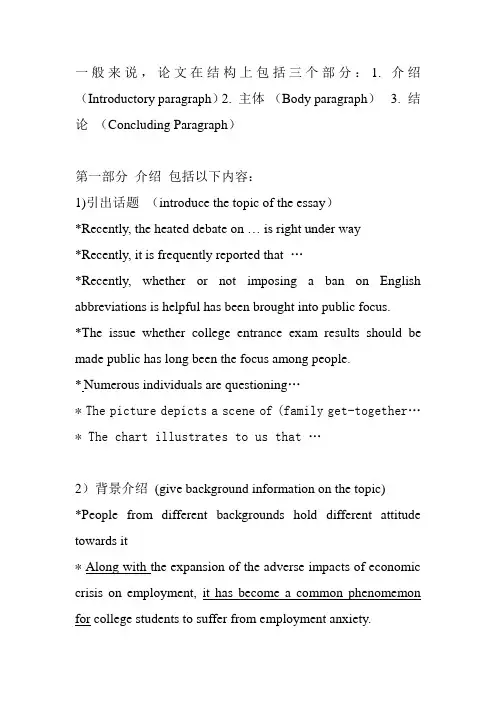
一般来说,论文在结构上包括三个部分:1. 介绍(Introductory paragraph)2. 主体(Body paragraph) 3. 结论(Concluding Paragraph)第一部分介绍包括以下内容:1)引出话题(introduce the topic of the essay)*Recently, the heated debate on … is right under way*Recently, it is frequently reported that …*Recently, whether or not imposing a ban on English abbreviations is helpful has been brought into public focus.*The issue whether college entrance exam results should be made public has long been the focus among people.*Numerous individuals are questioning…* The picture depicts a scene of (family get-together…* The chart illustrates to us that …2)背景介绍(give background information on the topic)*People from different backgrounds hold different attitude towards it* Along with the expansion of the adverse impacts of economic crisis on employment, it has become a common phenomemon for college students to suffer from employment anxiety.*There are different opinions about it.[3) 主题句(thesis statement),包括(1)话题可被细分为几个方面(subdivisions of the topic) (2) 论文结构格局(organization pattern)Six of the most useful patterns of essay organization in thesis statements:Process-and-analysis:We can make waste water reusable by undergoing a three-stage treatment process: primary treatment, secondary treatment, and tertiary treatment.Division-and-classification:The outbreak of war in 1914 stirred many young soldiers to poetry to express their newly-found sense of beauty and dearness of the homeland which they might never see again.Cause-and-effect: Many college athletes graduate as functional illiterates because they have much ground training and little academic learning.Comparison-and-contrast: The music that my generation dances to is different from that of my parents both in language and melody.Exemplification: The public behavior of some sports figures is a poor example of illiteracy, arrogance, and violence for ouryouth.Definition:Machismo is an ancient concept that still affects male-female relationships in many Latin American cultures.]第二部分主体包括以下内容:1)中心句(topic sentence)2)论证过程(supporting details)3)过渡词(Transitional words)4)小结句(Concluding sentence)How to Develop the Paragraph:1. The Topic Sentence:1) The controlling idea of a paragraph will appear in the form of a topic sentence.2) A topic sentence announces and controls the content of a paragraph3) The topic sentences of each paragraph in your exam aresometimes stated in Chinese. In this case, all you need dois to translate them into English2. The Process of using your supporting details in a paragraphcan take on many forms:Explanation (解释)Definition (定义)Division (分类)Analysis (分析)Discussion (讨论)Description (描写)Example (举例)Comparison (比较)Statistical evidence (统计数据)Quotations from authorities (引用)Logical and reasonable argument (逻辑推理)3. Transition Words:First, next, then, finally, however, besides, in addition, apart from,Furthermore, nonetheless, in spite of, despite, as a result, in fact, as far as I know, etc.4. concluding sentence:A concluding sentence serves three purposes:-It signals the end of the paragraph-It summarizes the main points of the paragraph-It gives a final comment on your topic and leaves the reader with the most important ideas to think about.第三部分结论包括以下内容:1)对主要观点的总结(summary of the main idea)2)你的评论或自己的观点(your final comment)*Therefore, in my opinion, …*From my perspective, I am in favour of …*Personally, I firmly insist that…* In conclusion, …。
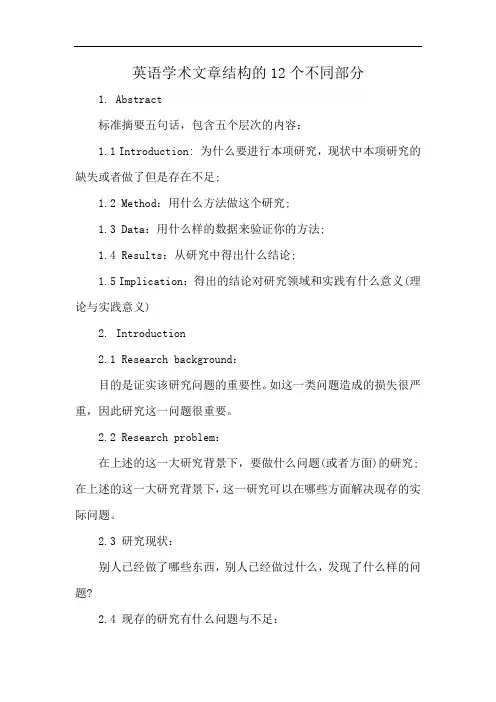
英语学术文章结构的12个不同部分1. Abstract标准摘要五句话,包含五个层次的内容:1.1 Introduction: 为什么要进行本项研究,现状中本项研究的缺失或者做了但是存在不足;1.2 Method:用什么方法做这个研究;1.3 Data:用什么样的数据来验证你的方法;1.4 Results:从研究中得出什么结论;1.5 Implication:得出的结论对研究领域和实践有什么意义(理论与实践意义)2. Introduction2.1 Research background:目的是证实该研究问题的重要性。
如这一类问题造成的损失很严重,因此研究这一问题很重要。
2.2 Research problem:在上述的这一大研究背景下,要做什么问题(或者方面)的研究;在上述的这一大研究背景下,这一研究可以在哪些方面解决现存的实际问题。
2.3 研究现状:别人已经做了哪些东西,别人已经做过什么,发现了什么样的问题?2.4 现存的研究有什么问题与不足:别人有什么没有做过?为什么别人没有做得更好?并说明这些研究不足会带来严重后果。
2.5 本研究的目标(objective)和研究范围(scope):本研究弥补这些问题中(这些没做过或者做过没做好的问题中)的哪些不足,采用什么研究方法去弥补不足。
陈述本项研究的范围局限,并高度概括本论文研究结论。
2.6 文章结构:本论文的后续部分的基本内容架构。
3. Literature review目的:Literature review证明与说明两件事情:一是研究目标的设定是有意义的;二是你在本研究中采用的方法是可靠的、有效的。
包括三个层次的内容:3.1 对选题(你找到的研究问题)的justification。
即对做过没做好或者没做过的研究问题,在这个研究领域,针对research problem而言,让读者明白本项研究是有意义的;3.2 现存文献中对本文值得参考并可借鉴的东西(包括分析工具和成果);3.3 非相关或者相邻研究领域值得借鉴的东西,侧重于可借鉴的研究方法。
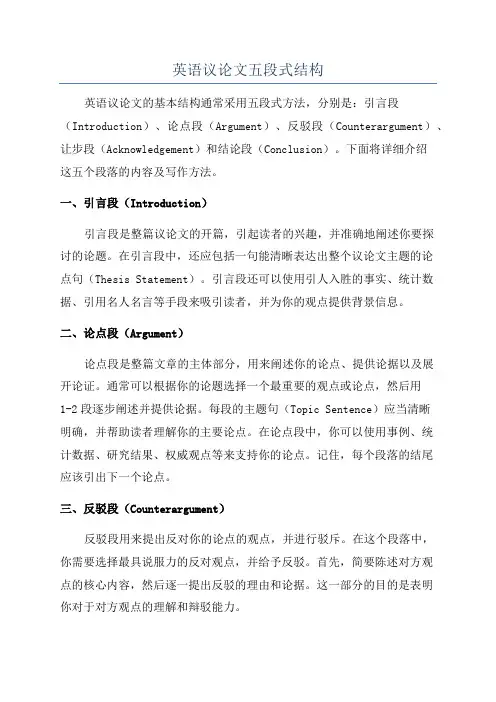
英语议论文五段式结构英语议论文的基本结构通常采用五段式方法,分别是:引言段(Introduction)、论点段(Argument)、反驳段(Counterargument)、让步段(Acknowledgement)和结论段(Conclusion)。
下面将详细介绍这五个段落的内容及写作方法。
一、引言段(Introduction)引言段是整篇议论文的开篇,引起读者的兴趣,并准确地阐述你要探讨的论题。
在引言段中,还应包括一句能清晰表达出整个议论文主题的论点句(Thesis Statement)。
引言段还可以使用引人入胜的事实、统计数据、引用名人名言等手段来吸引读者,并为你的观点提供背景信息。
二、论点段(Argument)论点段是整篇文章的主体部分,用来阐述你的论点、提供论据以及展开论证。
通常可以根据你的论题选择一个最重要的观点或论点,然后用1-2段逐步阐述并提供论据。
每段的主题句(Topic Sentence)应当清晰明确,并帮助读者理解你的主要论点。
在论点段中,你可以使用事例、统计数据、研究结果、权威观点等来支持你的论点。
记住,每个段落的结尾应该引出下一个论点。
三、反驳段(Counterargument)反驳段用来提出反对你的论点的观点,并进行驳斥。
在这个段落中,你需要选择最具说服力的反对观点,并给予反驳。
首先,简要陈述对方观点的核心内容,然后逐一提出反驳的理由和论据。
这一部分的目的是表明你对于对方观点的理解和辩驳能力。
四、让步段(Acknowledgement)让步段用来表明你主张的论点并不是绝对正确,存在一定的局限性。
在这个段落中,你可以通过承认一些相对的真实性或合理性来增加你论点的可信度。
与此同时,你仍然要强调自己的观点正确性的主要方面。
这部分的目的是表明你能够考虑到问题的多方面角度,并加强你的论证力度。
五、结论段(Conclusion)结论段是整篇文章的总结和结束。
在结论段中,你需要重新强调你的主要观点和论点,并总结你的关键论证。

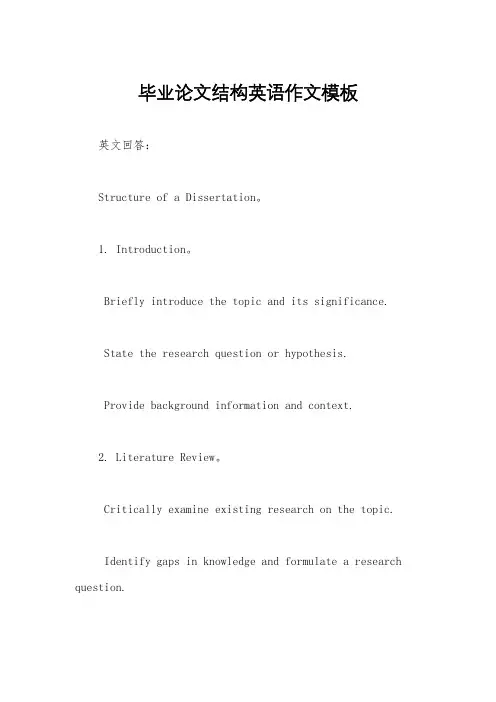
毕业论文结构英语作文模板英文回答:Structure of a Dissertation。
1. Introduction。
Briefly introduce the topic and its significance. State the research question or hypothesis.Provide background information and context.2. Literature Review。
Critically examine existing research on the topic.Identify gaps in knowledge and formulate a research question.Establish the theoretical framework for the dissertation.3. Methodology。
Describe the research design, methods, and data collection techniques.Justify the choice of methodology and ensure its validity and reliability.Outline the ethical considerations of the research.4. Results。
Present the findings from the data analysis.Use tables, charts, and figures to illustrate the results.Discuss the implications of the findings.5. Discussion。
Interpret the results in light of the research question and theoretical framework.Relate the findings to existing literature and identify areas of convergence and divergence.Discuss the limitations of the study and suggest directions for future research.6. Conclusion。
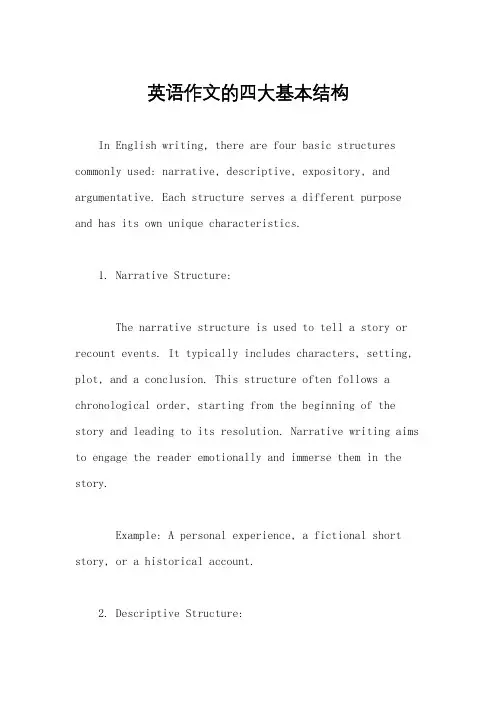
英语作文的四大基本结构In English writing, there are four basic structures commonly used: narrative, descriptive, expository, and argumentative. Each structure serves a different purpose and has its own unique characteristics.1. Narrative Structure:The narrative structure is used to tell a story or recount events. It typically includes characters, setting, plot, and a conclusion. This structure often follows a chronological order, starting from the beginning of the story and leading to its resolution. Narrative writing aims to engage the reader emotionally and immerse them in the story.Example: A personal experience, a fictional short story, or a historical account.2. Descriptive Structure:Descriptive writing focuses on creating a vivid picture of a person, place, object, or event. It uses sensory details such as sight, sound, smell, taste, and touch to paint a clear image in the reader's mind. Descriptive essays appeal to the reader's senses and emotions, allowing them to experience the subject vicariously.Example: Describing a beautiful sunset, a bustling city street, or a beloved family member.3. Expository Structure:Expository writing aims to explain, inform, or instruct the reader about a specific topic. It presents facts, statistics, definitions, or explanations in a clear and logical manner. This structure often includes subheadings, bullet points, or numbered lists to organize information effectively. Expository essays provide objective analysis and strive to educate the reader on a subject.Example: Explaining the process of photosynthesis, discussing the causes of climate change, or outlining the steps to writing a resume.4. Argumentative Structure:Argumentative writing presents a claim or thesis statement and supports it with evidence and reasoning. It aims to persuade the reader to accept a particular viewpoint or take a specific action. This structure includes a clear introduction, body paragraphs with supporting evidence, counterarguments, and a conclusion. Argumentative essays require critical thinking and the ability to present a compelling argument.Example: Arguing for or against the use of technology in education, advocating for stricter gun control laws, or debating the merits of a vegetarian diet.In conclusion, the four basic structures of English writing—narrative, descriptive, expository, andargumentative—each serve a distinct purpose and require different approaches. Whether you're telling a story, painting a picture, explaining a concept, or persuading an audience, choosing the appropriate structure is essential for effectively communicating your message.。
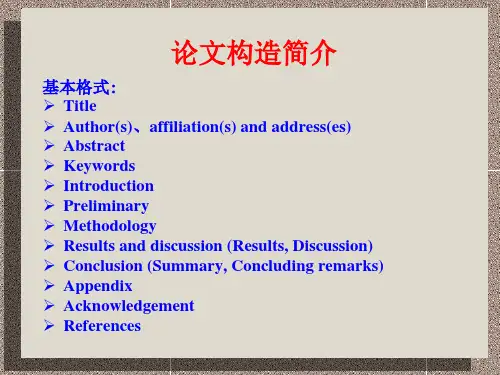
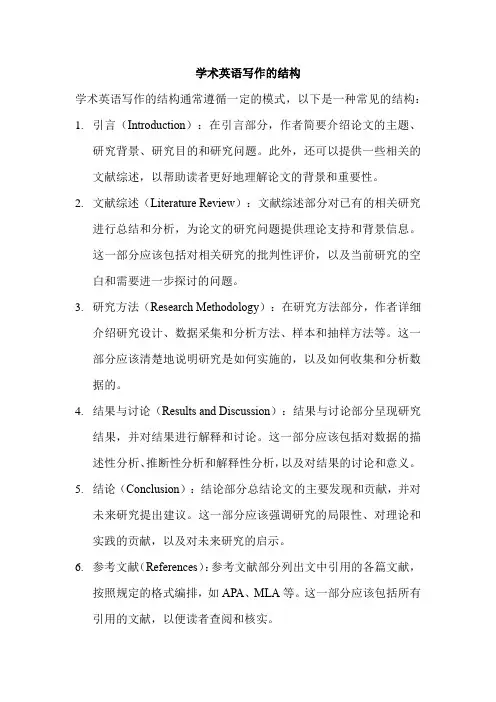
学术英语写作的结构
学术英语写作的结构通常遵循一定的模式,以下是一种常见的结构:1.引言(Introduction):在引言部分,作者简要介绍论文的主题、
研究背景、研究目的和研究问题。
此外,还可以提供一些相关的文献综述,以帮助读者更好地理解论文的背景和重要性。
2.文献综述(Literature Review):文献综述部分对已有的相关研究
进行总结和分析,为论文的研究问题提供理论支持和背景信息。
这一部分应该包括对相关研究的批判性评价,以及当前研究的空白和需要进一步探讨的问题。
3.研究方法(Research Methodology):在研究方法部分,作者详细
介绍研究设计、数据采集和分析方法、样本和抽样方法等。
这一部分应该清楚地说明研究是如何实施的,以及如何收集和分析数据的。
4.结果与讨论(Results and Discussion):结果与讨论部分呈现研究
结果,并对结果进行解释和讨论。
这一部分应该包括对数据的描述性分析、推断性分析和解释性分析,以及对结果的讨论和意义。
5.结论(Conclusion):结论部分总结论文的主要发现和贡献,并对
未来研究提出建议。
这一部分应该强调研究的局限性、对理论和实践的贡献,以及对未来研究的启示。
6.参考文献(References):参考文献部分列出文中引用的各篇文献,
按照规定的格式编排,如APA、MLA等。
这一部分应该包括所有引用的文献,以便读者查阅和核实。
以上是一种常见的学术英语写作结构,但具体的结构安排可能因学科领域、论文类型和个人偏好而有所不同。
在写作时,作者应该根据论文的具体要求和规范进行适当的调整。
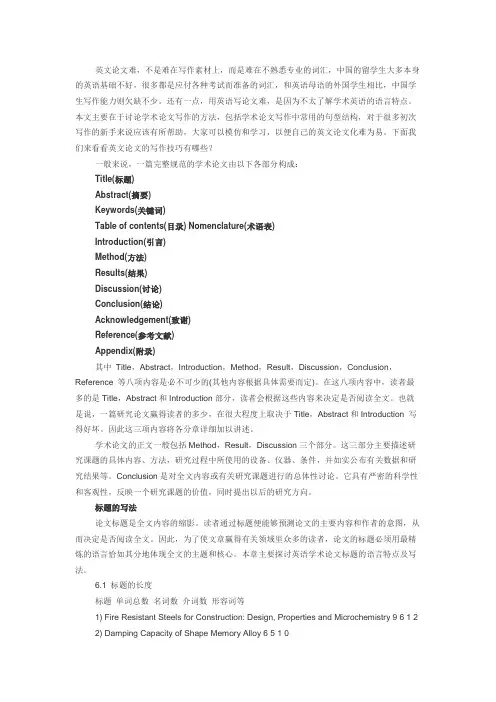
英文论文难,不是难在写作素材上,而是难在不熟悉专业的词汇,中国的留学生大多本身的英语基础不好,很多都是应付各种考试而准备的词汇,和英语母语的外国学生相比,中国学生写作能力则欠缺不少。
还有一点,用英语写论文难,是因为不太了解学术英语的语言特点。
本文主要在于讨论学术论文写作的方法,包括学术论文写作中常用的句型结构,对于很多初次写作的新手来说应该有所帮助,大家可以模仿和学习,以便自己的英文论文化难为易。
下面我们来看看英文论文的写作技巧有哪些?一般来说,一篇完整规范的学术论文由以下各部分构成:Title(标题)Abstract(摘要)Keywords(关键词)Table of contents(目录) Nomenclature(术语表)Introduction(引言)Method(方法)Results(结果)Discussion(讨论)Conclusion(结论)Acknowledgement(致谢)Reference(参考文献)Appendix(附录)其中Title,Abstract,Introduction,Method,Result,Discussion,Conclusion,Reference 等八项内容是必不可少的(其他内容根据具体需要而定)。
在这八项内容中,读者最多的是Title,Abstract和Introduction部分,读者会根据这些内容来决定是否阅读全文。
也就是说,一篇研究论文赢得读者的多少,在很大程度上取决于Title,Abstract和Introduction 写得好坏。
因此这三项内容将各分章详细加以讲述。
学术论文的正文一般包括Method,Result,Discussion三个部分。
这三部分主要描述研究课题的具体内容、方法,研究过程中所使用的设备、仪器、条件,并如实公布有关数据和研究结果等。
Conclusion是对全文内容或有关研究课题进行的总体性讨论。
它具有严密的科学性和客观性,反映一个研究课题的价值,同时提出以后的研究方向。
英文文章的常用篇章结构:Introduction1.Interest drawing material.2.Thesis statement3.3.Transitional sentenceBody(One or more paragraphs)1. (Transitional sentence or phrase)2. Topic sentence.3. Developments.4. (Transitional sentence)Ending1. (Transitional sentence or phrase )2. Conclusion, summary, restatement of the thesis, etc.开篇部分或称引言部分(introduction)的长短无定式,可以因为不同文体,不同题材,不同作者风格而有所不同。
吸引读者兴趣的材料(interest drawing material)可以多种多样。
可以是一句惊世骇俗论断(如一位女性作者在文章第一句就说“I also want a wife”),可以是一段逸闻趣事,可以是发人深省的问题,可以是名人学者的一段语录,也可以是一个具体情景的细致生动的描述。
这样的材料短则一句,长则一段甚至数段。
主题陈述(thesis statement)相当于中文所说的中心思想。
但是,受中国传统文化的影响,中文作者往往讲究含蓄、隐而不露。
因此中文文章的中心思想往往需要读者自己去归纳总结。
英文则相反。
英文文章讲究逻辑性、一致性、连贯性,讲究“重点先表达”。
因而可以在开篇部分找到thesis的重要信息。
主题陈述的特征是一个需要发展支持,可以而且实际上也被文章的主体部分发展支持的一个论断或陈述(a statement that requires development or support, one that can be, and is practically covered by the body of the essay)。
英语作文写法结构在撰写英语作文时,遵循一定的结构是非常重要的,这有助于清晰地表达你的思想,并使读者更容易理解你的观点。
以下是英语作文的基本结构:1. Introduction(引言)- Hook(吸引读者注意的开头): 开始时用一个引人入胜的故事、一个有趣的事实、一个引人思考的问题或者一个大胆的声明来吸引读者的注意力。
- Background Information(背景信息): 提供一些背景信息,让读者了解作文的主题和背景。
- Thesis Statement(论点): 明确地表达你的主题和论点,这是你作文的中心思想。
2. Body Paragraphs(主体段落)- Topic Sentence(主题句): 每个段落的第一句话应该是主题句,它概述了该段落的主要内容。
- Supporting Details(支持细节): 提供具体的例子、事实、统计数据或引用来支持你的主题句。
- Explanation(解释): 解释这些细节如何支持你的论点。
- Transitions(过渡): 使用过渡词或短语来连接你的思想,并帮助读者跟随你的论点。
3. Counterarguments(反驳论点)- 如果适用,可以包括一段来讨论并反驳可能的反对意见,这有助于加强你的论点。
4. Conclusion(结论)- Restate Thesis(重述论点): 重述你的论点,但不要直接复制引言中的句子。
- Summarize Main Points(总结要点): 简要回顾你的主要论点和支持细节。
- Closing Thought(结束语): 以一个强有力的结论来结束你的作文,这可以是一个引用、一个呼吁行动或一个令人难忘的声明。
5. Proofreading and Editing(校对和编辑)- 在完成初稿后,仔细校对和编辑你的作文,检查语法错误、拼写错误、标点符号以及逻辑上的不连贯之处。
记住,一篇好的英语作文不仅要有清晰的结构,还要有连贯的逻辑、准确的语言和有说服力的论据。
英语写作中的基本结构在英语写作中,良好的基本结构是成功的关键。
一个清晰的结构能够帮助读者更好地理解你的文章,使文章更有说服力。
那么,什么是英语写作中的基本结构呢?本文将介绍几种常见的结构和技巧,以帮助你写作。
一、五段式结构五段式结构是英语写作中最常用的结构之一。
它由五个部分组成:引言、论述1、论述2、论述3和结论。
每个部分都有具体的目的和作用,并按照一定的顺序排列。
引言:引言是文章的开始部分,用于引起读者的兴趣并引出你要讨论的话题。
它应该包含一个概括性陈述和一个独特的论点,以阐明你的中心思想。
论述1:在论述1中,你将进一步阐述你的中心思想,并提供支持你观点的详细信息。
这通常是你的最强有力的论据。
论述2:在论述2中,你将继续为你的论点提供证据。
这个部分通常要比论述1略次一些。
论述3:在论述3中,你将提供最后一组的证据来证明你的观点,并为你的立论做出总结。
这通常是你提供最弱的证据和观点。
结论:在结论中,你将对你的观点进行总结,并再次点明你的中心思想。
这是你告诉读者此文意愿的地方。
结论既可以是一个总结,也可以是一个预测或建议。
二、三段式结构三段式结构也是常见的结构之一。
它由三个部分组成:引言、论述和结论。
相比于五段式结构而言,三段式结构能够更简洁地传达你的中心思想,但需要更具有条理性。
引言:引言通常在文章的起始部分,用于引起读者的兴趣和建立你的中心思想。
它应该包含一个有力的陈述和一个独特的论点。
论述:在论述中,你要紧扣中心思想进行展开,提供有力的证据和数据来支持你的立论。
结论:在结论中,你将对你的中心思想进行总结并再次点明你的观点。
结论可以是一个总结、预测、或建议。
三、故事线结构故事线结构是一种较为灵活的结构,它通常适用于叙事性文章。
在这种结构中,作者将用一个故事或情景来引导文章的整个阅读过程,在一定程度上吸引读者的注意力。
可以在文章开头用一个有趣的故事和场景来吸引读者的注意力,然后逐渐引出你所要表达的观点。
论文中的英文写作技巧与表达方式在英文学术论文的写作过程中,准确和流畅的表达是非常重要的。
本文将探讨一些论文中的英文写作技巧及表达方式,帮助读者提升论文写作的能力。
1. 写作结构论文的结构对于阐明观点、组织思路至关重要。
以下是一般英文学术论文的常见结构:(1)引言:介绍论文的主题,概述论文的目的和重要性,并提供背景知识。
(2)文献综述:回顾相关的学术研究和理论,评估前人的研究成果。
(3)方法论:描述研究方法、实验设计和数据分析方法。
(4)结果:对实验结果进行客观的描述和分析。
(5)讨论:解释和解读结果,并与前人的研究进行比较和讨论。
(6)结论:总结研究成果,强调重要性和可能的进一步研究方向。
2. 语法和拼写良好的语法和拼写是论文写作的基础。
以下是一些常见的语法和拼写错误,需要注意避免:(1)主谓一致:主语和谓语动词在人称和单复数上要保持一致。
(2)时态一致:使用正确的时态表达,如过去时、现在时或将来时等。
(3)冠词使用:正确使用冠词(a、an、the),并避免过度使用。
(4)拼写错误:仔细校对论文中的拼写错误,可以使用拼写检查工具进行辅助。
3. 学术词汇在写作过程中,合适的学术词汇能够提升论文的专业程度,但过度使用学术词汇反而会让读者难以理解。
以下是一些建议:(1)避免使用口语化的表达方式,如俚语或缩写。
(2)使用学术词汇丰富论文内容,但确保这些词汇确实适用于所描述的概念。
(3)使用词汇表达准确的思想和观点,同时避免以讹传讹,对所使用词汇的准确性要有严谨要求。
4. 表达清晰在论文写作中,清晰的表达是非常重要的。
以下是一些建议:(1)使用简洁的句子结构和控制篇幅,避免过长的句子或段落。
(2)使用逻辑的连接词,如"however"、"therefore"、"in addition"等,帮助读者理解论文的逻辑。
(3)对于复杂的概念,使用图表或实例来解释,以帮助读者更好地理解。
英文论文难,不是难在写作素材上,而是难在不熟悉专业的词汇,中国的留学生大多本身的英语基础不好,很多都是应付各种考试而准备的词汇,和英语母语的外国学生相比,中国学生写作能力则欠缺不少。
还有一点,用英语写论文难,是因为不太了解学术英语的语言特点。
本文主要在于讨论学术论文写作的方法,包括学术论文写作中常用的句型结构,对于很多初次写作的新手来说应该有所帮助,大家可以模仿和学习,以便自己的英文论文化难为易。
下面我们来看看英文论文的写作技巧有哪些?一般来说,一篇完整规范的学术论文由以下各部分构成:Title(标题)Abstract(摘要)Keywords(关键词)Table of contents(目录)Nomenclature(术语表)Introduction(引言)Method(方法)Results(结果)Discussion(讨论)Conclusion(结论)Acknowledgement(致谢)Reference(参考文献)Appendix(附录)其中 Title,Abstract,Introduction,Method,Result,Discussion,Conclusion,Reference 等八项内容是必不可少的(其他内容根据具体需要而定)。
在这八项内容中,读者最多的是Title,Abstract和Introduction部分,读者会根据这些内容来决定是否阅读全文。
也就是说,一篇研究论文赢得读者的多少,在很大程度上取决于Title,Abstract和Introduction 写得好坏。
因此这三项内容将各分章详细加以讲述。
学术论文的正文一般包括Method,Result,Discussion三个部分。
这三部分主要描述研究课题的具体内容、方法,研究过程中所使用的设备、仪器、条件,并如实公布有关数据和研究结果等。
Conclusion是对全文内容或有关研究课题进行的总体性讨论。
它具有严密的科学性和客观性,反映一个研究课题的价值,同时提出以后的研究方向。
英语文章结构英语文章的结构通常遵循“引言-正文-结论”(Introduction-Body-Conclusion)的基本框架。
以下是对这三个部分的详细描述:1. 引言(Introduction):引言是文章的开头部分,主要目的是引出话题并引起读者的兴趣。
引言通常包括背景信息、文章主题和论文陈述。
通过引言,作者为正文部分做好铺垫,让读者了解文章的大致内容和方向。
引言的结构可以包括以下要素:- 背景信息:简要介绍与文章主题相关的背景信息,为读者提供基本的了解。
- 主题陈述:明确指出文章的主题,展示文章的核心内容。
- 论文陈述:提出文章的主要观点和论点,简要概括文章的结论。
2. 正文(Body):正文是文章的核心部分,主要包含文章的论证和论据。
正文通常分为若干段落,每个段落阐述一个主要观点并辅以相关的证据和例子。
段落之间应保持逻辑清晰、连贯一致。
正文的结构可以包括以下要素:- 主题句:每个段落的首句,概括段落的主要观点。
- 论证:提供支持主题句的证据和例子,使观点更具说服力。
- 反例与反驳:针对可能的反对意见提出反例,并加以反驳,使论证更加严密。
- 转折与过渡:使用适当的转折词和过渡句,使段落之间保持连贯性。
3. 结论(Conclusion):结论是文章的结尾部分,主要目的是总结全文的主要观点,并给读者留下深刻印象。
结论应简洁明了,避免引入新的观点或证据。
结论的结构可以包括以下要素:- 总结:简要回顾文章的主要观点和论据,强调文章的核心内容。
- 意义:指出文章的贡献和意义,展示其对读者和研究的价值。
- 建议与展望:提出未来研究的方向和建议,启发读者的思考。
总之,英语文章结构遵循“引言-正文-结论”的基本原则,通过引言引出话题,正文进行论证,结论进行总结,使文章条理清晰、逻辑严密。
在撰写英语文章时,作者应关注这三个部分的结构和要素,以确保文章的质量。
英文论文难,不是难在写作素材上,而是难在不熟悉专业的词汇,中国的留学生大多本身的英语基础不好,很多都是应付各种考试而准备的词汇,和英语母语的外国学生相比,中国学生写作能力则欠缺不少。
还有一点,用英语写论文难,是因为不太了解学术英语的语言特点。
本文主要在于讨论学术论文写作的方法,包括学术论文写作中常用的句型结构,对于很多初次写作的新手来说应该有所帮助,大家可以模仿和学习,以便自己的英文论文化难为易。
下面我们来看看英文论文的写作技巧有哪些?一般来说,一篇完整规范的学术论文由以下各部分构成:Title(标题)Abstract(摘要)Keywords(关键词)Table of contents(目录) Nomenclature(术语表)Introduction(引言)Method(方法)Results(结果)Discussion(讨论)Conclusion(结论)Acknowledgement(致谢)Reference(参考文献)Appendix(附录)其中Title,Abstract,Introduction,Method,Result,Discussion,Conclusion,Reference 等八项内容是必不可少的(其他内容根据具体需要而定)。
在这八项内容中,读者最多的是Title,Abstract和Introduction部分,读者会根据这些内容来决定是否阅读全文。
也就是说,一篇研究论文赢得读者的多少,在很大程度上取决于Title,Abstract和Introduction 写得好坏。
因此这三项内容将各分章详细加以讲述。
学术论文的正文一般包括Method,Result,Discussion三个部分。
这三部分主要描述研究课题的具体内容、方法,研究过程中所使用的设备、仪器、条件,并如实公布有关数据和研究结果等。
Conclusion是对全文内容或有关研究课题进行的总体性讨论。
它具有严密的科学性和客观性,反映一个研究课题的价值,同时提出以后的研究方向。
标题的写法论文标题是全文内容的缩影。
读者通过标题便能够预测论文的主要内容和作者的意图,从而决定是否阅读全文。
因此,为了使文章赢得有关领域里众多的读者,论文的标题必须用最精炼的语言恰如其分地体现全文的主题和核心。
本章主要探讨英语学术论文标题的语言特点及写法。
6.1 标题的长度标题单词总数名词数介词数形容词等1) Fire Resistant Steels for Construction: Design, Properties and Microchemistry 9 6 1 22) Damping Capacity of Shape Memory Alloy 6 5 1 03) Microelectronic Assembly and Packaging Technology: Barriers and Needs 8 5 0 314) Solid Oxide Fuel Cell: A Survey 6 4 0 25) Progress on Fuel Cell and Its Materials 7 4 1 26) Computer Simulation and Experimental Study on Cold Shut During Mold Filling 11 5 2 4英语科技论文中,标题不宜过长,大多为8—12个单词左右。
英文论文引言的写作技巧学术论文中的引言(Introduction)是对全文内容和结构的总体勾画。
引言尽管不像摘要那样有一定的篇幅限制和相对固定的格式,但在内容和结构模式上也有需要遵循的规律。
本章首先介绍这些规律,然后探讨需要掌握的语言技巧。
8.1 引言的内容与结构布局引言的主要任务是向读者勾勒出全文的基本内容和轮廓。
它可以包括以下五项内容中的全部或其中几项:介绍某研究领域的背景、意义、发展状况、目前的水平等;对相关领域的文献进行回顾和综述,包括前人的研究成果,已经解决的问题,并适当加以评价或比较;指出前人尚未解决的问题,留下的技术空白,也可以提出新问题、解决这些新问题的新方法、新思路,从而引出自己研究课题的动机与意义;说明自己研究课题的目的;概括论文的主要内容,或勾勒其大体轮廓。
如何合理安排以上这些内容,将它们有条有理地给读者描绘清楚,并非容易之事。
经验告诉我们,引言其实是全文最难写的—部分。
这是因为作者对有关学科领域的熟悉程度,作者的知识是渊博、还是贫乏,研究的意义何在、价值如何等问题,都在引言的字里行间得以充分体现。
我们可以将引言的内容分为三到四个层次来安排(如图8.1所示)。
第一层由研究背景、意义、发展状况等内容组成,其中还包括某一研究领域的文献综述;第二层提出目前尚未解决的问题或急需解决的问题,从而引出自己的研究动机与意义;第三层说明自己研究的具体目的与内容;最后是引言的结尾,可以介绍一下论文的组成部分。
第一层:1) Introducing the general research area including its background, importance, and present level of development……………………………………………………………2) Reviewing previous research in this area……………………………………………………………………第二层:Indicating the problem that has not been solved by previous research, raising a relevantquestion ……………………………………………………………………………………………………………………………………………………………………………………………第三层:Specifying the purpose of your research………………………………………………………………………………………………………………第四层:1) Announcing your majorfindings …………………………………………………………………………………………………………2) Outlining the contents of yourpaper …………………………………………………………………………………………………………………………………………………………………………………图8.1 引言的结构布局之一值得注意的是,引言中各个层次所占的篇幅可以有很大差别。
这一点与摘要大不一样,摘要中的目的、方法、结果、结论四项内容各自所占的篇幅大体比例一样(见7.2节)。
而在引言中,第一个层次往往占去大部分篇幅。
对研究背景和目前的研究状况进行较为详细的介绍。
研究目的可能会比较简短。
引言与摘要还有一点不同的是,摘要中必须把主要研究结果列出,而在引言中(如果摘要与正文一同登出)结果则可以省略不写,这是因为正文中专门有一节写结果(results),不必在引言中重复。
下面这段引言的例子摘自一篇关于混合电动汽车的研究论文,大部分篇幅介绍研究背景。
sample 1A Hybrid Internal Combustion Engine/Battery Electric Passenger Car for Petroleum Displacement I. Forster and J. R. Bumby INTRODUCTION [1] The finite nature of the world's oil resources and the general concern about automobile emissions have prompted the adoption of energy conservation policies and emphasized the need to transfer energy demand from oil to other sources of energy, such as natural gas, coal and nuclear. [2] A transfer of energy from oil to electricity can be achieved to a limited extent in the road trans- port sector by the increased use of electric vehicle. However, such vehicles are limited in range due to the amount Of energy that can he realistically stored on-board the vehicle without affecting payload. As a consequence of this, electric vehicles must he used in situations where daily usage is well defined, for example, in urban delivery duty. Indeed, it has been in such vehicles as the urban milk delivery vehicles that electric traction drives have been traditionally applied with a great deal of success. Currently the demand is for urban electric vehicles to he developed with greater traffic compatibility in terms of speed and range.分析:第一层(第1—5段):介绍混合电动汽车的研究背景、意义、目前的发展水平,需要解决的问题等。
第1段:指出混合电动汽车的研究背景。
世界石油资源的有限性及人们对汽车排放问题的广泛关注使得能源转换问题尤为重要。
第2段:使用电动汽车能够从某种程度上实现能源转换。
但问题是电动汽车的续驶里程比内燃机车短。
所以目前要解决的问题是提高电动汽车的速度和续驶里程。
[3] Although urban delivery vehicle applications will help to reduce the dependence of the road transport sector on petroleum-based fuels, the major part of this market requires vehicles that are not limited in range and have a performance compatible with internal combustion, i.e. engine vehicles. The use of advanced traction battery technology to overcome the range limitation of electric vehicles is one possible solution. However, this would still result in a vehicle limited in range and may in itself create additional problems. For example, due to the much greater on- board stored energy, the charging time required will be greater than at present. [4] The range limitations of the pure electric vehicle can be overcome by using a hybrid i.c. engine/electric drive which incorporates both an i.c. engine and an electric traction system. Al- though such a vehicle can be designed to meet a number of objectives, it has been argued that a vehicle which seeks to remove the range limitation of the electric vehicle while substituting a substantial amount of petroleum fuel by electrical energy is the vehicle most worth pursuing. With the emphasis of the vehicle design on the electric drive train, the intention may be to operate in an all-electric mode under urban conditions and to use the i.c. engine for long-distance motorway driving. The hybrid mode could then he used for extending urban range and/or improving vehicle accelerative performance on accelerator kick-down.[5] The concept of a hybrid electric vehicle capable of substituting petroleum fuel is' not new, 第3段:市场要求电动汽车的续驶里程及工作性能与内燃机汽车媲美,但是,即使先进电池可以提高电动汽车的续驶里程,但还会有一些问题不能解决。